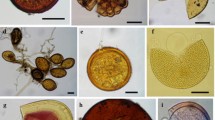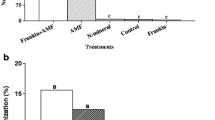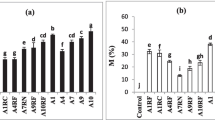Abstract
This paper investigates the distribution of arbuscular mycorrhizal fungi (AMF) spores and AMF colonization in a field study in southeastern Brazil. Response to AMF and rhizobial inoculation was studied in monocultures of Plathymenia reticulata and mixed plantations with both Tabebuia heptaphylla and Eucalyptus camaldulensis in a sandy soil during two consecutive years. P. reticulata height and diameter and mycorrhizal colonization and AMF diversity were measured in dry and rainy periods. The inoculated treatment of E. camaldulensis, T. heptaphylla and P. reticulata mixed plants showed higher height and diameter growth of P. reticulata used as well as increased root colonization and AMF spore numbers. Spore populations were found to belong to five genera: Acaulospora, Entrophospora, Glomus, Gigaspora and Scutellospora, with Glomus dominating. Agroforestry practices including use of leguminous tree P. reticulata effectively maintained AMF spore numbers in soils and high AMF colonization levels compared with monocultures, proving an efficient system for productivity and sustainability.





Similar content being viewed by others
References
Adjoud D, Plenchette C, Halli-Hargas R et al (1996) Response of 11 Eucalyptus species to inoculation with three arbuscular mycorrhizal fungi. Mycorrhiza 6:129–135. doi:10.1007/s005720050117
Adjoud-Sadadou D, Halli-Hargas R (2000) Occurrence of arbuscular mycorrhiza on aged Eucalyptus. Mycorrhiza 9:287–290. doi:10.1007/PL00009993
Albuquerque PP (2008) Diversidade de Glomeromycetes e atividade microbiana em solos sob vegetação nativa do Semi-Árido de Pernambuco. Doctor’s thesis. Universidade Federal do Pernambuco, Recife
Aristizábal C, Rivera EL, Janos DP (2004) Arbuscular mycorrhizal fungi colonize decomposing leaves of Myrica parvifolia, M. pubescens and Paepalanthus sp. Mycorrhiza 14:4. doi:10.1007/s00572-003-0259-0
Augé RM, Schekel KA, Wample RL (1987) Leaf water and carbohydrate status of VA mycorrhizal rose exposed to drought stress. Plant Soil 99:291–302. doi:10.1007/BF02370876
Barea JM, Toro M, Orozco MO et al (2002) The application of isotopic (32P and 15N) dilution techniques to evaluate the interactive effect of phosphate solubilizing rhizobacteria, mycorrhizal fungi, and Rhizobium to improve agronomic efficiency of rock phosphate for legume crops. Nutr Cycl Agroecosyst 63:35–42. doi:10.1023/A:1020589732436
Binkley D, Dunkin KA, DeBell D et al (1992) Production and nutrient cycling in mixed plantations of Eucalyptus and Albizia in Hawaii. For Sci 38:393–408
Brundrett MC, Bougher NL, Dell B (1996) Working with mycorrhizas in forestry and agriculture. Monograph 32. ACIAR, Canberra
Cardoso IM, Kuyper TW (2006) Mycorrhizas and tropical soil fertility. Agric Ecosyst Environ 116:72–84. doi:10.1016/j.agee.2006.03.011
Cardoso IM, Boddington C, Janssen BH et al (2003) Distribution of mycorrhizal fungal spores in soils under agroforestry and monocultural coffee systems in Brazil. Agrofor Syst 58:33–43. doi:10.1023/A:1025479017393
Carneiro MAC, Siqueira JO, Moreira FMS et al (1998) Micorriza arbuscular em espécies arbóreas e arbustivas nativas de ocorrência no Sudeste do Brasil. Cerne 4:129–145
Carrenho R, Barbosa FF, Araújo CVM, Alves IJ, Santos OM (2008) Mycorrhizal associations in Eucalyptus spp.: status and needs. Tree For Sci Biotechnol 2(1):57–67
Chalk PM, Souza RF, Urquiaga S et al (2006) The role of arbuscular mycorrhiza in legume symbiotic performance. Soil Biol Biochem 38:2944–2951. doi:10.1016/j.soilbio.2006.05.005
Chen YL, Liu S, Dell B (2007) Mycorrhizal status of Eucalyptus plantations in south China and implications for management. Mycorrhiza 17:527–535. doi:10.1007/s00572-007-0125-6
Chilvers GA, Lapeyrie FF, Horan DP (1987) Ectomycorrhizal vs endomycorrhizal fungi within the same root system. New Phytol 107:441–448. doi:10.1111/j.1469-8137.1987.tb00195.x
Codevasf (2004) Distrito de Irrigação de Jaíba, total de precipitação mensal dos últimos dez anos. Writed Report
Conn C, Dighton J (2000) Litter quality influences on decomposition, ecto-mycorrhizal community structure and mycorrhizal root surface acid phosphatase activity. Soil Biol Biochem 32:489–496. doi:10.1016/S0038-0717(99)00178-9
Córdoba AS, Mendonça MM, Stürmer SL et al (2001) Diversity of arbuscular mycorrhizal fungi along a sand dune stabilization gradient: a case study at Praia da Joaquina, Ilha de Santa Catarina, South Brazil. Mycoscience 42:379–387. doi:10.1007/BF02461221
Courty PE, Pouységur R, Buée M et al (2006) Laccase and phosphatase activities of the dominant ectomycorrhizal types in a lowland oak forest. Soil Biol Biochem 38:1219–1222. doi:10.1016/j.soilbio.2005.10.005
Cuenca G, De Andrade Z, Escalante G (1998) Arbuscular mycorrhizae in the rehabilitation of fragile degraded tropical lands. Biol Fertil Soils 26:107–111. doi:10.1007/s003740050351
DeBell D, Whitesell CD, Schubert TH (1985) Mixed plantation of Eucalyptus and leguminous tree enhance biomass production. Pacific Southwest forest and Range Experiment Station Forest Service. US Department of Agriculture, Res Paper PSW-175. Berkeley, CA
Dhar PP, Mridha MAU (2006) Biodiversity of arbuscular mycorrhizal fungi in different trees of Madhupur forest, Bangladesh. J For Res 17:201–205. doi:10.1007/s11676-006-0047-8
Empresa Brasileira de Pesquisa Agropecuária (1979) Manual de Análises Químicas de solos, plantas e fertilizantes. Embrapa, Brasília
Empresa Brasileira de Pesquisa Agropecuária (1999) Sistema brasileiro de classificação de solos. Centro Nacional de Pesquisa de Solos. Embrapa, Brasília
Faria MP, Vale FR, Siqueira JO et al (1995) Crescimento de leguminosas arbóreas em resposta a fósforo, fungo micorrízico e rizóbio. II. Peltophorum dubium (Spreng.) Taub. R Árv 19:433–446
Gerdemann JW, Nicolson TH (1963) Spores of mycorrhizal Endogone species extracted from soil by wet sieving and decanting. Trans Br Mycol Soc 84:679–684
Giri B, Giang PH, Kumari R (2003) Mycorrhizosphere: strategies and functions. In: van der Heijden MGA, Sanders IR (eds) Mycorrhizal ecology. Springer, Berlin
Gross E, Cordeiro L, Caetano FH (2004) Nodulação e micorrização em Anadenanthera peregrina var. falcata em solo de cerrado autoclavado e não autoclavado. R Bras Ci Solo 28:95–101
Haas JH, Menge JA (1990) VA mycorrhizal fungi and soil characteristics in avocado (Persea americana Mill.) orchard soil. Plant Soil 127:207–212. doi:10.1007/BF00014427
Hart MM, Klironomos JN (2003) Diversity of arbuscular mycorrhizal fungi and ecosystem functioning. In: van der Heijden MGA, Sanders IR (eds) Mycorrhizal ecology. Springer, Berlin
Hodge A, Campbell CD, Fitter AH (2001) An arbuscular mycorrhizal fungus accelerates decomposition and acquires nitrogen directly from organic material. Nature 413:297–299. doi:10.1038/35095041
Kennedy LJ, Tiller RL, Stutz JC (2002) Associations between arbuscular mycorrhizal fungi and Sporobolus wrightii in riparian habitats in arid south-west North America. J Arid Environ 50:459–475. doi:10.1006/jare.2001.0899
Khanna PK (1997) Nutrient cycling under mixed-species tree systems in southeast Asia. Agrofor Syst 38:99–120. doi:10.1023/A:1005952410569
Killham K (1994) Soil ecology. Cambridge University Press, UK, 242 p
Kirk JL, Beaudette LA, Hart M et al (2004) Methods of studying soil microbial diversity. J Microbiol Methods 58:169–188. doi:10.1016/j.mimet.2004.04.006
Klironomos JN, Hart MM (2002) Colonization of roots by arbuscular mycorrhizal fungi using different sources of inoculum. Mycorrhiza 12:181–184. doi:10.1007/s00572-002-0169-6
Kögel-Knabner I (2002) The macromolecular organic composition of plants and microbial residues as inputs to soil organic matter. Soil Biol Biochem 34:139–162. doi:10.1016/S0038-0717(01)00158-4
Koske RE, Tessier B (1983) A convenient, permanent slide mounting medium. Mycol Soc Am Newsl 34:59
Lovelock CE, Andersen K, Morton JB (2003) Arbuscular mycorrhizal communities in tropical forests are affected by host tree species and environment. Oecol 135:268–279
Magurran AE (1988) Ecological diversity and its measurement. Croom Helm, London
Maia LC, Trufem SFB (1990) Fungos micorrízicos vesículo-arbusculares em solos cultivados no Estado de Pernambuco, Brasil. Rev Bras Bot 1:89–95
Manjunath A, Bagyaraj DJ, Gopala Gowda HS (1984) Dual inoculation with VA mycorrhiza and Rhizobium is beneficial to Leucaena. Plant Soil 78:445–448. doi:10.1007/BF02450380
Marques MS, Pagano MC, Scotti MR (2001) Dual inoculation of woody legume (Centrolobium tomentosum) with rhizobia and mycorrhizal fungi in southeastern Brazil. Agrofor Syst 52:107–117. doi:10.1023/A:1010637401475
Marschner H, Dell B (1994) Nutrient uptake in mycorrhizal symbiosis. Plant Soil 159:89–102
Matsumoto LS, Martines AM, Avanzi MA et al (2005) Interactions among functional groups in the cycling of carbon, nitrogen and phosphorus in the rhizosphere of three successional species of tropical woody trees. Appl Soil Ecol 28:57–65. doi:10.1016/j.apsoil.2004.06.008
May BM, Attiwill PM (2003) Nitrogen-fixation by Acacia dealbata and changes in soil properties 5 years after mechanical disturbance or slash-burning following timber harvest. For Ecol Manage 181:339–355
McGonigle TP, Miller MH, Evans DG et al (1990) A new method which gives an objective measure of colonization of roots by vesicular-arbuscular mycorrhizal fungi. New Phytol 115:495–501. doi:10.1111/j.1469-8137.1990.tb00476.x
Miller RM, Jastrow JD (1992) The role of mycorrhizal fungi in soil conservation. In: Bethlenfalvay GJ, Linderman RG (eds) Mycorrhizae in sustainable agriculture. American Society of Agronomy, Madison, pp 29–44
Morton JB (1988) Taxonomy of VA mycorrhizal fungi: classification, nomenclature and identification. Mycotaxon 32:267–324
Muleta D, Assefa F, Nemomissa S et al (2008) Distribution of arbuscular mycorrhizal fungi spores in soils of smallholder agroforestry and monocultural coffee systems in southwestern Ethiopia. Biol Fertil Soils 44:653–659. doi:10.1007/s00374-007-0261-3
Muthukumar T, Udaiyan K (2002) Seasonality of vesicular arbuscular mycorrhizae in sedges in a semi-arid tropical grassland. Acta Oecol 23:337–347. doi:10.1016/S1146-609X(02)01165-7
Nouaim R, Chaussod R (1996) Rôle des mycorhizes dans l’alimentation hydrique et minérale dês plantes, notamment des ligneux de zones arides. CIHEAM—Options Mediterraneennes
Pagano MC, Cabello MN, Scotti MR (2007) Phosphorus response of three native Brazilian trees to inoculation with four arbuscular mycorrhizal fungi. J Agric Technol 3:231–240
Pagano MC, Cabello MN, Bellote AF et al (2008) Intercropping system of tropical leguminous species and Eucalyptus camaldulensis, inoculated with rhizobia and/or mycorrhizal fungi in semiarid Brazil. Agrofor Syst 74:231–242. doi:10.1007/s10457-008-9177-7
Panwar J, Tarafdar JC (2006) Distribution of three endangered medicinal plant species and their colonization with arbuscular mycorrhizal fungi. J Arid Environ 65:337–350. doi:10.1016/j.jaridenv.2005.07.008
Parrota JA (1999) Productivity, nutrient cycling, and succession in single- and mixed-species plantations of Casuarina equisetifolia, Eucalyptus robusta, and Leucaena leucocephala in Puerto Rico. For Ecol Manage 124:45–77
Phillips JM, Hayman DS (1970) Improved procedures for clearing roots and staining parasitic and vesicular mycorrhizal fungi for rapid assessment of infection. Trans Br Mycol Soc 55:158–161
Picone C (2000) Diversity and abundance of arbuscular-mycorrhizal fungus spores in tropical forest and pasture. Biotropica 32:734–750. doi:10.1646/0006-3606(2000)032[0734:DAAOAM]2.0.CO;2
Prado DE (2003) As Caatingas de América do Sul. Seção I. Padrões de diversidade e distribuição das espécies em escala regional. In: Leal IR, Tabarelli M, da Silva JMC (eds) Ecologia e Conservação da Caatinga. Ed. Universitária da UFPE, Recife, pp 1–74
Read DJ (1990) Ecological integration by mycorrhizal fungi. Endocytobiology 4:99–107
Read DJ (1991) Mycorrhizas in ecosystems. Experientia 47:376–391. doi:10.1007/BF01972080
Rizzini CT (1997) Tratado de fitogeografia do Brasil: aspectos ecológicos, sociológicos e florísticos. Âmbito Cultural Edições Ltda
Rodrigues MGV, Souto RF, Menegucci JLP (2001) Influência do ensacamento do cacho na produção de frutos da bananeira `Prata-Anã′ irrigada, na região Norte de Minas Gerais. Rev Bras Frutic 23:559–562
Rodrigues LA, Martins MA, Salomão MSMB (2003) Uso de micorrizas e rizóbio em cultivo consorciado de eucalipto e sesbânia. I—crescimento, absorção e transferência de nitrogênio entre plantas. Rev Bras Cienc Do Solo 27:583–591
Santos VL, Muchovej RM, Borges AC et al (2001) Vesicular-arbuscular-ecto-mycorrhiza succession in seedlings of Eucalyptus spp. Braz J Microbiol 32:81–86. doi:10.1590/S1517-83822001000200002
Schenck NC, Pérez Y (1988) Manual for the identification of VA mycorrhizal fungi, INVAM. University of Florida, Gainesville
Scotti MR, Correa EJA (2004) Growth and litter decomposition of woody species inoculated with rhizobia and arbuscular mycorrhizal fungi in Semiarid Brazil. Ann Sci 61:87–95. doi:10.1051/forest:2003088
Silva SO, Pires ET, Pestana RKN et al (2006) Evaluation of cavendish banana clones. Ciênc agrotec 30:832–837
Simard WS, Jones MD, Durall DM (2003) Carbon and nutrient fluxes within and between mycorrhizal plants. In: van der Heijden MGA, Sanders IR (eds) Mycorrhizal ecology. Springer, Berlin
Simpson D, Daft MJ (1990) Interaction between water stress and different mycorrhizal inocula on plant growth and mycorrhizal development in maize and sorghum. Plant Soil 121:179–186. doi:10.1007/BF00012310
Siqueira JO, Saggin-Júnior OJ (2001) Dependency on arbuscular mycorrhizal fungi and responsiveness of some Brazilian native woody species. Mycorrhiza 11:245–255. doi:10.1007/s005720100129
Siqueira JO, Colozzi-Filho A, de Oliveira E (1989) Occurrence of vesicular-arbuscular mycorrhizae in agro- and natural ecosystem of Mina Gerais State. Pesquisa Agropecu Bras 24:1499–1506
Smith SE, Read DJ (1997) Mycorrhizal symbiosis. Academic Press, Inc., London
Somasegaran P, Hoben HJ (1985) Methods in legume-Rhizobium technology. NIFTAL, Hawaii
Souza RG, Maia LC, Sales MF, Trufem SFB (2003) Diversidade e potencial de infectividade de fungos micorrízicos arbusculares em área de caatinga, na Região de Xingo, Estado de Alagoas, Brasil. Rev Brasil Bot 26:49–60
Stutz JC, Copeman R, Martin CA, Morton JB (2000) Patterns of species composition and distribution of arbuscular mycorrhizal fungi in arid regions of southwestern North America and Namibia, Africa. Can J Bot 78:237–245. doi:10.1139/cjb-78-2-237
Subramanian KS, Charest C, Dwyer LM et al (1997) Effects of arbuscular mycorrhizae on leaf water potential, sugar content, and P content during drought and recovery of maize. Can J Bot 75:1582–1591. doi:10.1139/b97-870
Tarafdar JC, Praveen-Kumar (1996) The role of vesicular arbuscular mycorrhizal fungi on crop, tree and grasses in an arid environment. J Arid Environ 34:197–203. doi:10.1006/jare.1996.0101
Tian C, He X, Zhong Y et al (2003) Effect of inoculation with ecto- and arbuscular mycorrhizae and Rhizobium on the growth and nitrogen fixation by black locust, Robinia pseudoacacia. New For 25:125–131. doi:10.1023/A:1022675915627
van der Heijden MGA (2003) Arbuscular mycorrhizal fungi as a determinant of plant diversity: in search of underlying mechanisms and general principles. In: van der Heijden MGA, Sanders IR (eds) Mycorrhizal ecology. Springer, Berlin
van der Heijden MGA, Boller T, Wiemkem A et al (1998) Different arbuscular mycorrhizal fungal species are potential determinants of plant community structure. Ecology 79:2082–2091
Varma A (1995) Arbuscular mycorrhiza fungi: the state of the art. Crit Rev Biotechnol 15:179–199. doi:10.3109/07388559509147407
Walker C, Mize W, McNabb HS (1982) Populations of endogonaceous fungi at two locations in central Iowa. Can J Bot 60:2518–2529. doi:10.1139/b82-305
Wright SF, Upadhyaya A (1998) A survey of soils for aggregate stability and glomalin, a glycoprotein produced by hyphae of arbuscular mycorrhizal mycorrhizal fungi. Plant Soil 198:97–107. doi:10.1023/A:1004347701584
Yano-Melo AM, Maia LC, Morgado LB (1997) Fungos micorrízicos arbusculares em bananeiras cultivadas no vale do submédio São Francisco. Acta Bot Bras 11:115–121
Yano-Melo AM, Trufem SFB, Maia LC (2003) Arbuscular mycorrhizal fungi in salinized and surrounded areas at the São Francisco Submedium Valley, Brazil. Hoehnea 30:79–87
Zambolim L, Barros NF (1982) Constatação de micorriza vesicular-arbuscular em Eucalyptus spp. na região de Viçosa, MG. Rev Arvore 6:95–97
Zangaro W, Nisizaki SMA, Domingos JCB et al (2003) Mycorrhizal response and successional status in 80 woody species from south Brazil. J Trop Ecol 19:315–324. doi:10.1017/S0266467403003341
Zhao ZW, Wang GH, Yang L (2003) Biodiversity of arbuscular mycorrhizal fungi in a tropical rainforest of Xishuangbanna, southwest China. Fungal Divers 13:233–242
Acknowledgments
This research was supported by the Ministry of Environment: National Found of Environment (FNMA). The authors are grateful to the Council for the Development of Higher Education at Graduate Level, Brazil (CAPES) for a scholarship granted to Marcela C. Pagano. Marta N. Cabello is a researcher from Comisión de Investigaciones Científicas (CIC), Argentina.
Author information
Authors and Affiliations
Corresponding author
Rights and permissions
About this article
Cite this article
Pagano, M.C., Scotti, M.R. & Cabello, M.N. Effect of the inoculation and distribution of mycorrhizae in Plathymenia reticulata Benth under monoculture and mixed plantation in Brazil. New Forests 38, 197–214 (2009). https://doi.org/10.1007/s11056-009-9140-0
Received:
Accepted:
Published:
Issue Date:
DOI: https://doi.org/10.1007/s11056-009-9140-0




